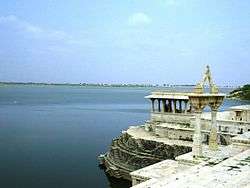Rajsamand Lake
| Rajsamand Lake | |
|---|---|
 Ghat of Rajsamand lake with pavilions and toranas | |
| Location | Rajasthan |
| Coordinates | 25°04′N 73°53′E / 25.07°N 73.88°ECoordinates: 25°04′N 73°53′E / 25.07°N 73.88°E |
| Type | reservoir |
| Catchment area | 196 sq mi (510 km2) |
| Basin countries | India |
Rajsamand Lake (also known as Rajsamudra Lake) is a lake near the town of Rajsamand in the Indian state of Rajasthan. Built in the 17th century, it is approximately 1.75 miles (2.82 km) wide, 4 miles (6.4 km) long and 60 feet (18 m) deep. It was built across the Gomati, Kelwa, and Tali rivers, with a catchment area of approximately 196 sq mi (510 km2).
Rajsamand Lake is one of the five popular lakes of Mewar. Located 66 km in the north of Udaipur, Rajsamand Lake lies between the cities of Rajnagar and Kankroli. It is also known by the name of Rajsamudra Lake in Rajasthan. Rajsamand Lake was built by Maharana Raj Singh in 1660.
The river Gomti is the main supplier of water to Rajsamand Lake. This was created by building an impressive dam in the 17th century. On the southern end of the lake, the huge embankment is composed of white marble. It has marble terraces and stone steps that touch the waters of the lake. There are five toranas (weighing arches) where Maharana Raj Singh and his descendants organized the annual event of Tuladan. (Kings used to weigh themselves in gold and then distribute it amongst the Brahmans.) This process of alms-giving was followed by Maharaja Raj Singh and his descendants.[1]
Also on the embankment of the lake are nine pavilions or 'nauchowki' (nine ghats), which were constructed by Maharana Raj Singh. These beautifully carved pavilions are festooned with pictures of the sun, chariots, gods, birds and detailed carvings. The history of Mewar is inscribed in 1017 stanzas, on 27 marble slabs, that are called the Raj Prasasti. It has been acclaimed as one of the longest etchings in India.
Rajsamand Lake was made the seaplane base of Imperial Airways during World War II, for over six years.
At sunset, the waters of the lake glitter with the startling light of the sun. However, the mining of marble in the catchment area in the last three decades has caused irreparable damage to the source of the water. The rain water is now diverted elsewhere and the lake remains mostly dry.